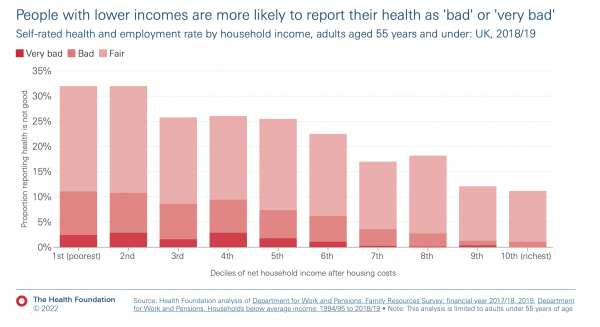Our health is one of the most important things in life, but it can sometimes come at a cost. This blog will look at the links between poverty and poorer health, by discussing various pieces of research.
Access to Healthcare
Research conducted by Newcastle University and the University of Cumbria in partnership with Children North East found that families on low incomes can face difficulties in attending appointments at their GP surgery, hospital and dentist.
Despite NHS care being free, parents that the researchers spoke to reported lots of ‘hidden costs’ that they found made it hard for those on low incomes to attend appointments. These included things like:
- Costs of travel
- Not having enough mobile phone credit to ring their doctor’s surgery
- Losing money from taking time off work for appointments
Some of the issues raised are experienced by all NHS users, such as appointments only being available when patients are meant to be working. However, for those on lower incomes, these kinds of issues can act as a bigger barrier to accessing healthcare.
‘Bad Health’ and Life Expectancy
According to The Health Foundation, those in the bottom 40% of income distribution are almost twice as likely to report poor health than those in the top 20%.

The above chart illustrates their findings that respondents on lower incomes are more likely to self-report being in bad health.
The Marmot Review found that life expectancy follows a social gradient wherein the more deprived the area, the shorter the average life expectancy.
“The health of the population is not just a matter of how well the health service is funded and functions, important as that is. Health is closely linked to the conditions in which people are born, grow, live, work and age and inequities in power, money and resources – the social determinants of health.” – Health Equity in England: The Marmot Review 10 Years On
Diet and Lifestyle
Poverty can mean that people lack access to basic foods and services, are unable to heat their homes consistently, and are more likely to face food insecurity.
“Food insecurity (FI) is a multifaceted, socioeconomic problem involving difficulties accessing sufficient, safe and nutritious food to meet people’s dietary requirements and preferences for a healthy life.” – ‘Child food insecurity in the UK: a rapid review,’ Aceves-Martins et al
For those experiencing poverty, it can be far harder to maintain a healthy lifestyle. Eating healthily does not always come without cost…
A 2023 Government Survey found that 25% of households in the most deprived areas reported eating less fruit and veg due to cost-of-living increases. And it isn’t just the poorest people facing a strain here either, with 8% of the least deprived quantile also reporting eating less fruit and veg due to cost increases.
Additionally, some people lack access to household appliances that many of us take for granted as everyday items. In fact, Turn2us found that 9% of people in the UK have no freezer, 6% have no cooker, and 3% have no fridge. Without these basic appliances, meals can become far more expensive, as people are more likely to turn to fast food outlets and microwave meals. Turn2us found that living without a cooker for example, and relying on microwave meals as a result, adds around £2,1000 to a yearly food bill.
Overall, research shows that our income can have an impact on our health in a variety of ways. However, this does not mean everyone experiencing poverty or living on a low income has an unhealthy lifestyle; it just means they may face some more challenges to maintaining full health.